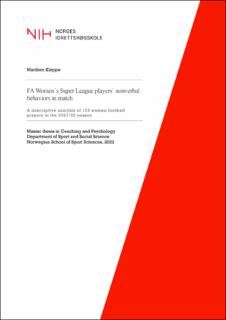| dc.description.abstract | Background: Psychological abilities is emerging as one the most important attributes for successful football players (Haugaasen & Jordet, 2012). However, extended research on players` nonverbal behavior (NVB) in sport is lacking (Furley, 2021), which means that people do not know much about how players communicate nonverbally on the pitch during a match. Furthermore, there are limited research on women in sport (Persson et al., 2020), indicating it was particularly interesting to investigate women´s NVB.
Purpose: The overall purpose of this study was to examine the nature and frequency of women football players` nonverbal behaviors in a match.
Methods: A non-participatory observation was conducted. A total of 173 women football players (Mage = 25.9, SD = 3.8) from the top division in England (FA Women´s Super League) were coded descriptively. The players` nonverbal behaviors were coded in a league match using Hudl Sportscode.
Results: Women´s Super League players had a mean frequency of 2.15 nonverbal behaviors per minute (SD = 1.141) and an average of 214.88 in a full match. Most of the nonverbal behaviors were coded as tactical (85.4%). Results revealed that mean frequency of tactical, positive, and negative NVB differed in the different playing positions. Furthermore, teams ahead encoded more positive NVB compared to negative NVB than teams behind and at level. Also, winning teams were more positive than losing teams and tied teams, and losing teams were more negative than winning teams and tied teams. There were also differences in tactical behavior between tied teams compared to winning teams and losing teams. There was not found a relationship between NVB and game location. Captains had a higher frequency of positive and tactical NVB, but not negative, compared to the rest of the players. A relationship was also found between emotional behavior the last ten minutes of the game and game result.
Summary: This study was the first research conducted on women football players` NVB in a match. The results demonstrate that players` NVB vary across playing positions and roles, and dependent on the game status, and game result. The results provide practical implications for coaches, but further research is needed before conclusions can be made. Hopefully, the results can inspire further research on women football players` nonverbal behaviors in match and function as a guide for similar research methodology. | en_US |
